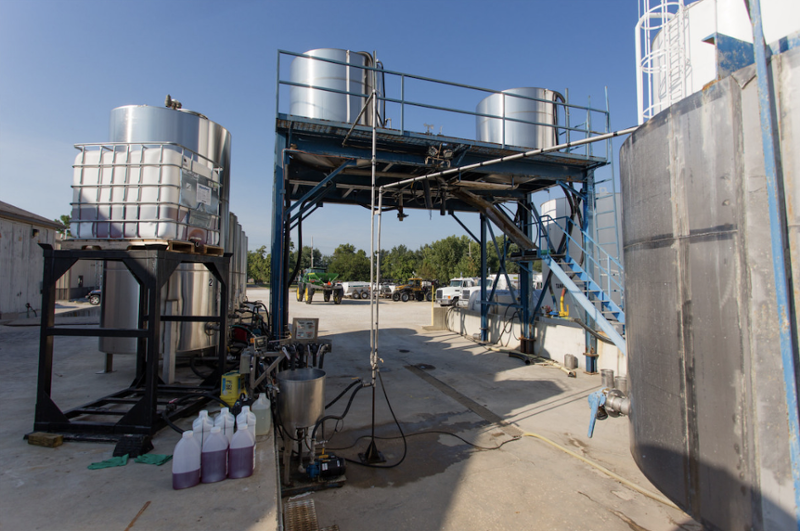
The U.S. Geological Survey says one in five wells in farming areas are contaminated with fertilizer byproducts at levels that exceed federal health limits. (United Soybean Board/flickr)
Pollution from chemical fertilizers in agricultural runoff affects water quality in rivers, lakes and oceans, while also emitting nitrous oxide, or "laughing gas," a greenhouse gas 300 times more potent than carbon dioxide.
Researchers and climate advocates warn that fertilizer and runoff lacks regulation and needs more intensive solutions to curb harmful effects.
In October last year, more than 150 scientists signed an open letter calling for world leaders to act against nitrogen pollution.
With so much focus on carbon dioxide emissions, nitrous oxide from agricultural runoff and other sources has flown under the policy radar, they warned.
“A future focus on sustainable nitrogen management would help prevent millions of premature deaths, help ensure food security, and simultaneously help protect wildlife and the ozone layer,” the letter said.
Center for Public Integrity, Grist and The World have reported in an investigative series about largely unregulated chemical fertilizer that the U.S. Environmental Protection Agency calls “one of America’s most widespread, costly and challenging environmental problems.”
Despite longstanding warnings from the EPA, agriculture has sidestepped the kind of federal oversight seen in other sectors that cause pollution.
In part, that’s because the industry falls under the control of state governments, who prefer recommendations and voluntary cooperation instead of rules and enforcement.
Investigators found that rules are often “derailed or softened after industry pushback and political pressure.”
Negative effects of fertilizer runoff have been severe.
Runoff from fields across the Midwest dump into the Mississippi, causing a huge plume of algae known as the Gulf of Mexico “dead zone,” an oxygen-deprived area off the coast of Louisiana and Texas that swells up to the size of Connecticut or New Jersey.
Last year, the dead zone grew to cover up to 6,952 square miles, according to the National Oceanic and Atmospheric Administration.
Globally, dead zones have quadrupled in the last 50 years as farmers increasingly grow subsidized, monoculture crops like corn, soybeans, biofuels and livestock feed.
The state of Iowa alone accounts for 4,800 railroad tanker cars, an average of about 13 per day.
A conservation group last month announced it plans to sue the EPA for dropping the ball on enforcement of rules to protect the Chesapeake Bay from contamination.
The Chesapeake Bay Foundation says the agency failed to enforce the Clean Water Act, and hamstrung efforts to reduce nitrogen pollution in the bay by 2025 with an annual $300 million funding shortfall.
Even before reaching the ocean, fertilizers feed algae toxic blooms in lakes, and evaporate into the air.
Those gasses can trigger asthma, and contaminated drinking water causes so-called blue baby syndrome, which blocks infants from absorbing oxygen.
The government spends about $6 billion every year on the problem, but investigators say the money has made little difference.
In Indiana, researchers are working on a model that could help.
A drainage experiment called the Shatto Ditch carries runoff from 5 square miles in northern Indiana.
Water travels through pipes that empty into an 8-mile ditch that wends through farmland, ultimately reaching the Tippecanoe River, the Wabash, the Ohio, and finally into Mississippi.
Researchers say a key solution is to plant cover crops like rye grass and clover to hold down the soil with roots during heavy rains.
When the Shatto project started, 12 percent of fields in the watershed had cover crops.
The group worked with farmers to increase that number to 67 percent.
Nationwide, only 4 percent of farmland grows cover crops.
After 6 years, the volume of water from pipes that drained into the ditch fell by about half, and nitrates fell between 80 and 50 percent, depending on the year.
In Nevada and California, a group of researchers from UC Riverside, University of Nevada, Reno and UC Santa Barbara received a $1.1 million grant from the National Science Foundation to study how nitrogen pollution affects arid land that has less vegetation to absorb nitrogen.
For the next three years, the team will study microbes, gasses and other indicators to work out how much nitrogen the sensitive ecosystems can handle before triggering negative effects.
The researchers said current models do a poor job of predicting how excess nitrogen moves through landscapes and hope better data will help regulators curb pollution from sources like chemical fertilizers.
Read More:
The Contaminant We Can’t Live Without (Grist)
Last-Ditch Effort (Grist)
Group Preparing to Sue EPA Over Chesapeake Bay Pollution (New York Times)
Scientists Study Nitrogen Pollution In Dryland Watersheds (Nevada Appeal)
Photo link: https://flickr.com/photos/unitedsoybean/10994535275/












